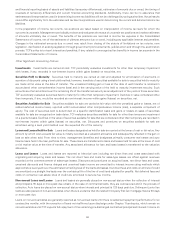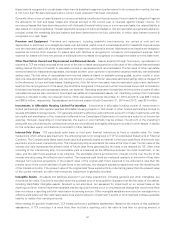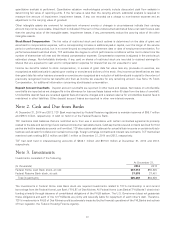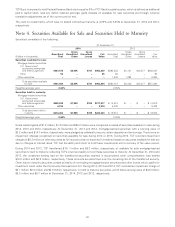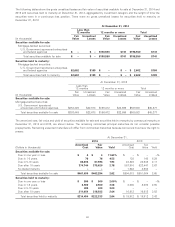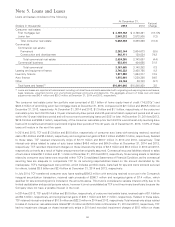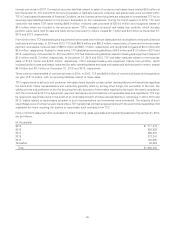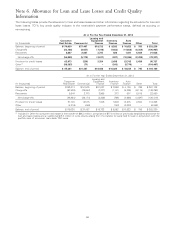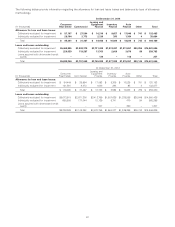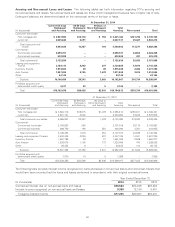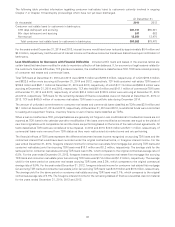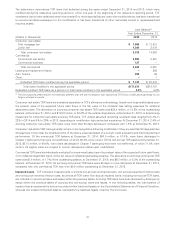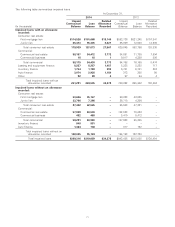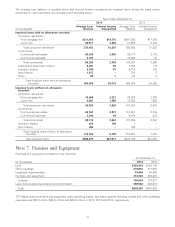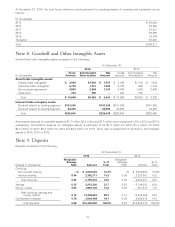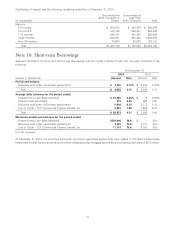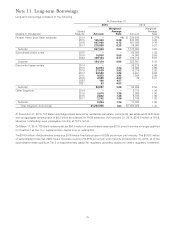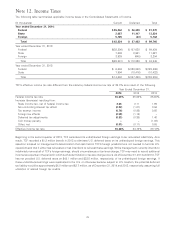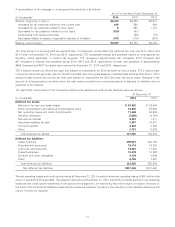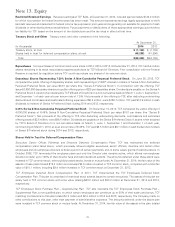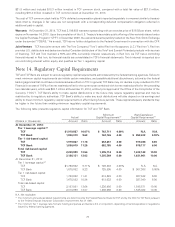TCF Bank 2014 Annual Report Download - page 82
Download and view the complete annual report
Please find page 82 of the 2014 TCF Bank annual report below. You can navigate through the pages in the report by either clicking on the pages listed below, or by using the keyword search tool below to find specific information within the annual report.
The following table provides information regarding consumer real estate loans to customers currently involved in ongoing
Chapter 7 or Chapter 13 bankruptcy proceedings which have not yet been discharged.
At December 31,
(In thousands) 2014 2013
Consumer real estate loans to customers in bankruptcy:
0-59 days delinquent and accruing $47,731 $65,321
60+ days delinquent and accruing 247 682
Non-accrual 12,284 13,475
Total consumer real estate loans to customers in bankruptcy $60,262 $79,478
For the years ended December 31, 2014 and 2013, interest income would have been reduced by approximately $0.4 million and
$0.9 million, respectively, had the accrual of interest income on the above consumer loans been discontinued upon notification of
bankruptcy.
Loan Modifications for Borrowers with Financial Difficulties Included within loans and leases in the previous tables are
certain loans that have been modified in order to maximize collection of loan balances. If, for economic or legal reasons related to
the customer’s financial difficulties, TCF grants a concession, the modified loan is classified as a TDR. TDR loans consist primarily
of consumer real estate and commercial loans.
Total TDR loans at December 31, 2014 and 2013 were $298.5 million and $796.5 million, respectively, of which $193.8 million
and $632.8 million were accruing at December 31, 2014 and 2013, respectively. TCF held consumer real estate TDR loans of
$199.6 million and $641.1 million at December 31, 2014 and 2013, respectively, of which $111.9 million and $506.6 million were
accruing at December 31, 2014 and 2013, respectively. TCF also held $91.6 million and $147.1 million of commercial TDR loans
at December 31, 2014 and 2013, respectively, of which $80.4 million and $120.9 million were accruing at December 31, 2014
and 2013, respectively. TDR loans for the remaining classes of finance receivables were not material at December 31, 2014 or
2013. TCF sold $405.9 million of consumer real estate TDR loans in a portfolio sale during December 2014.
The amount of unfunded commitments to consumer real estate and commercial loans classified as TDRs was $3.9 million and
$6.1 million at December 31, 2014 and 2013, respectively. At December 31, 2014 and 2013, no additional funds were committed
to leasing and equipment finance, inventory finance or auto finance loans classified as TDRs.
When a loan is modified as a TDR, principal balances are generally not forgiven. Loan modifications to troubled borrowers are not
reported as TDR loans in the calendar year after modification if the loans were modified at an interest rate equal to the yields of
new loan originations with comparable risk and the loans are performing based on the terms of the restructured agreements. All
loans classified as TDR loans are considered to be impaired. In 2014 and 2013, $12.8 million and $17.1 million, respectively, of
commercial loans were removed from TDR status as they were restructured at market terms and are performing.
The financial effects of TDR loans represent the difference between interest income recognized on accruing TDR loans and the
contractual interest that would have been recorded under the original contractual terms, or foregone interest income. For the
year ended December 31, 2014, foregone interest income for consumer real estate first mortgage lien accruing TDR loans and
consumer real estate junior lien accruing TDR loans was $16.7 million and $1.2 million, respectively. The average yield for the
same period on consumer real estate accruing TDR loans was 3.3%, which compares to the original contractual average rate of
6.8%. For the year ended December 31, 2013, foregone interest income for consumer real estate first mortgage lien accruing
TDR loans and consumer real estate junior lien accruing TDR loans was $17.6 million and $1.2 million, respectively. The average
yield for the same period on consumer real estate accruing TDR loans was 3.3%, which compares to the original contractual
average rate of 6.9%. For the year ended December 31, 2012, foregone interest income for consumer real estate first mortgage
lien accruing TDR loans and consumer real estate junior lien accruing TDR loans was $13.9 million and $0.9 million, respectively.
The average yield for the same period on consumer real estate accruing TDR loans was 3.7%, which compares to the original
contractual average rate of 6.9%. The foregone interest income for the remaining classes of finance receivables was not material
for the years ended December 31, 2014, 2013 and 2012.
69


